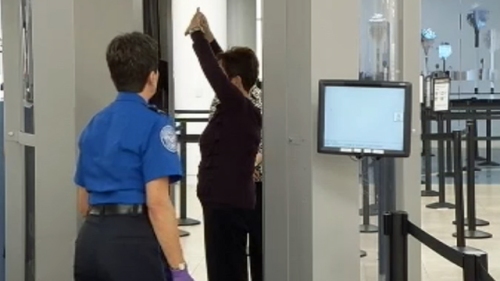It seems as if the massive DHS database of secret watchlists will continue to grow with U.S. citizens’ names even if the threat of terrorism does not.
While the TSA can’t explain why invasive patdowns without probable cause are legal, that isn’t stopping TSA from future plans to track all your daily travels, anywhere you go, from work, to stores, or even when you go out to play.
networkworld.com | Aug 23, 2012
By Ms. Smith
When the TSA was asked to provide legal reasons that definitely spelled out why physically invasive patdowns are legal, without any probable cause, not one TSA person had an answer. There was no legal documentation for enhanced patdowns other than it serves “the essential administrative purpose.”
Peep show, police state or privacy invasion, patdowns and body scans are not just in airports. EPIC said DHS is refusing to disclose details of mobile body scanner technology. In fact, in answer to EPIC’s FOIA request, DHS handed over “several papers that were completely redacted.”
Meanwhile at airports, the TSA is rolling out “less-invasive gingerbread man” body scanners to a tune of $2.7 million for 240 machines. At this point, I don’t think skinnier versions of the Pillsbury Doughboy via kinder and gentler naked body scans are going to placate people who are secretly murmuring that America is truly becoming a police state. Spending countless billions of dollars on all this ‘security theater’ makes it look like the TSA is “doing their best to ensure that if there’s a terrorist attack the public doesn’t blame the TSA for missing it.”
According to TSA Blogger Bob, in the 10 years after 9/11, there have been vast improvements and new technology as well as a “professionalized workforce” of Transportation Security Officers. Professional as in claiming no more enhanced groping of children under 12, only to break that promise and seemingly molest this little boy dressed as Spiderman?
The Los Angeles Times reported on TSA launching a behavior-detection program at Boston’s Logan International Airport. These TSA officers received a whopping two weeks of training and are supposed to ask each passenger a “few” questions “in an effort to detect suspicious behavior.” Doesn’t this seem like yet another strike at your privacy? Some people are stressed or even nervous when they are traveling. What if you don’t feel like talking or being questioned? Is this too going to become yet another TSA-mandated “you will answer if you want the privilege of flying?”
A MSNBC travel article warned that when it comes to airport security, “you ain’t seen nothing yet.” Some security analysts suggest Big Brother will employ an even Bigger Brother in the form of “chip-embedded passports that someday tell the federal transportation watchdogs all about your daily commutes to work, the mall — even to parties.”
Other security analysts suggest it will all be about “gathering intelligence technologically” or that increased biometrics is the security answer. The Known Traveler Program will launch this fall so previously known and trusted travelers will “have bar codes stamped on their boarding passes, authorizing TSA screeners to allow those passengers to skip shoe and laptop removals.” TSA Administrator John Pistole said, “Enhancing identity-based screening is another common sense step in the right direction as we continue to strengthen overall security and improve the passenger experience whenever possible.”
So even though the TSA is building up its ranks with bomb-sniffing dogs, there will be dramatic changes in store for travelers within the next 30 years. There will be biometric fingerprinting as well as other biometric and personal info stored in government databases.
Senior policy analyst at the Center for Health and Homeland Security Vernon R. Herron told MSNBC that your official travel document “will not only have information as to who you are and where you have traveled, but it will also … allow government officials to track your travel not only in the air, but your daily travels to work, grocery stores and social events.” In the future the “government will detain passengers who have traveled to places that are suspicious in nature” once they enter an airport, Herron added. “All these measures seem extreme. However, after we declared a war on terror, we must be more proactive than reactive when it comes to airport security.”
Ah, again with the “suspicious” lists even if it’s places to which you traveled this time. Regarding the dreaded list after list of supposed suspicious activity, are they meant to keep the public in a state of paranoia and fear so they just roll over and watch it happen? Digg commenter leodin said, “Strange… The actual threat of terrorism hasn’t increased, and the odds of actually dying in a terrorist attack make the lottery look like a sound investment, and yet the government seems insistent upon taking more and more measures to protect us from these imaginary threats.”
It seems as if the massive DHS database of secret watchlists will continue to grow with U.S. citizens’ names even if the threat of terrorism does not.









